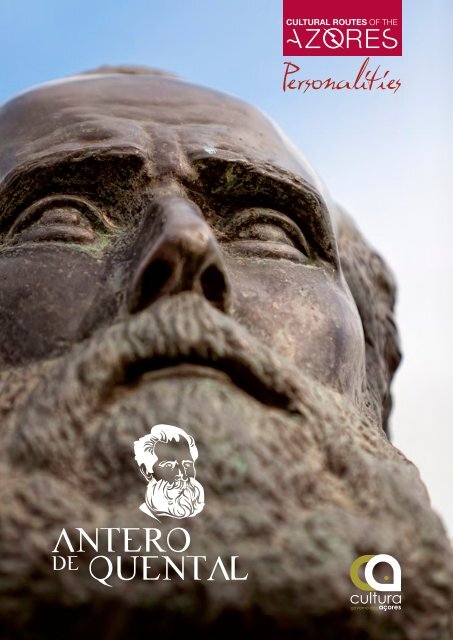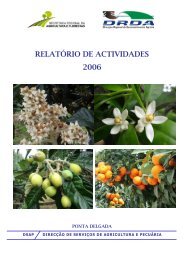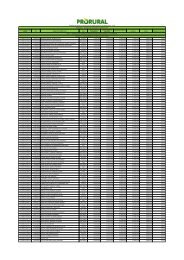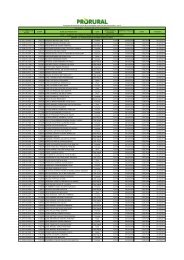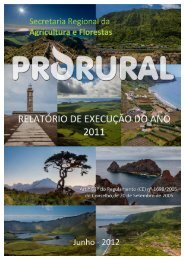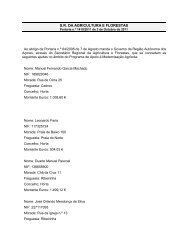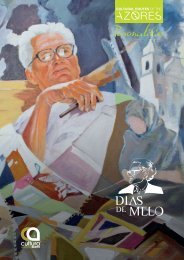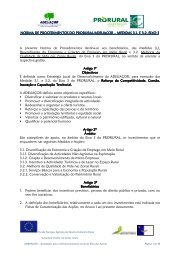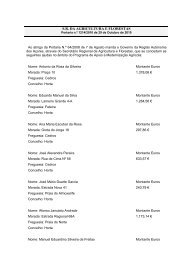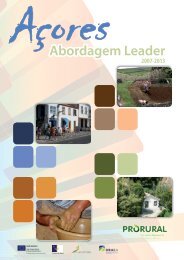Antero de Quental (Inglês)
Antero de Quental (Inglês)
Antero de Quental (Inglês)
You also want an ePaper? Increase the reach of your titles
YUMPU automatically turns print PDFs into web optimized ePapers that Google loves.
anguishes and elected <strong>de</strong>ath as the only chance for liberating the unconscious forces that markMan’s <strong>de</strong>stiny. In 1890, now in a euphoric phase, free from pessimistic <strong>de</strong>spair, he published EnsaioSobre as Tendências Gerais da Filosofia na última Meta<strong>de</strong> do Século XIX (Essay On the GeneralPhilosophical Ten<strong>de</strong>ncies in the Latter Half of the 19th Century). Finally, taking in the generaldisillusionment caused by the grave recession that hit the country and, tormented by family problems,he once again entered a <strong>de</strong>ep <strong>de</strong>pression which led him to commit suici<strong>de</strong> in Ponta Delgada onSeptember 11, 1891.Poetic activity structures <strong>Antero</strong> <strong>de</strong> <strong>Quental</strong>’s work. Thus, whereas poetry from his youth — Sonetos<strong>de</strong> <strong>Antero</strong> (Sonnets of <strong>Antero</strong>, 1861), O<strong>de</strong>s Mo<strong>de</strong>rnas (Mo<strong>de</strong>rn O<strong>de</strong>s, 1863) and PrimaverasRomânticas (Romantic Springs, 1872) — is highly marked by the i<strong>de</strong>als of Portuguese culturalrenewal, poetry from his mature days successively echo his pessimistic phase, most distinct ofwhich, are the sonnets that make up the series Elogio da Morte (Death’s Praise, 1875) and euphoricphase, documented in sonnets such as O Convertido (The Converted, 1875), Na Mão <strong>de</strong> Deus(In God’s Hand) and Re<strong>de</strong>nção (Re<strong>de</strong>mption, 1882), Voz Interior (Inner Voice, 1883), or “SolemniaVerba” (1884). His sonnets — poetic form in which he attained one of the most perfect <strong>de</strong>grees inthe history of Portuguese language literatures — were object of several editions in his life: in 1881he published the book Sonetos (Sonnets) and later, organized by Oliveira Martins, Sonetos Completos(Complete Sonnets, 1886); some of these poems were translated into German by Wilhelm Storck(1829-1905), translator of Camões to whom <strong>Antero</strong> sent an autobiographic letter (1887) containingimportant information to un<strong>de</strong>rstand his personality, his literary work, and his involvement in theenterprise of mo<strong>de</strong>rnizing Portuguese political and literary i<strong>de</strong>als.<strong>Antero</strong> <strong>de</strong> <strong>Quental</strong> was the undisputed spiritual lea<strong>de</strong>r of the generation of brilliant intellectualyoungsters which would become known as the “70s Generation”, among which, besi<strong>de</strong>s him, wereEça <strong>de</strong> Queiroz, Teófilo Braga (1843-1924), Oliveira Martins (1845-1894), Ramalho Ortigão andBatalha Reis. After his <strong>de</strong>ath, these and other friends collaborated in the volume <strong>Antero</strong> <strong>de</strong> <strong>Quental</strong>— In Memoriam (1896), with texts that are precious testimonies of the man and his work, andthrough him, of the generation to which he belonged — one of the most dynamic and productivein terms of the renewal of thought, literature and politics in Portugal. Eça <strong>de</strong> Queiroz, who in InMemoriam collaborated with the text Um Génio Que Era Um Santo (A Genious who was a Saint)— crucial to know the man <strong>Antero</strong> was, from a friend, a companion and a critic’s perspective— sketched out in the novel A Capital! (The Capital!) (written between 1877 and 1884, never finished),an acrimonious portrait of <strong>Antero</strong> and other companions of the Coimbrã generation, himselfinclu<strong>de</strong>d, where <strong>Antero</strong> lives through the character Damião, a socialist activist intellectual who, afterleading his generation in Coimbra University, hovers, cold and brilliant over the interests and theincompatibilities of the political parties who cannot and don’t know how to manage, in the field, theprogrammatic legacy of the 1870s generation.It is this fascinating character and his path through life and <strong>de</strong>ath, measured between i<strong>de</strong>alisticeuphoria and the <strong>de</strong>spair of disillusionment, characteristic of the Portuguese intellectual circles ofthe last quarter of the 19th century, which we have adopted as a gui<strong>de</strong> to revisiting the city of PontaDelgada — his cradle, his refuge and his tomb.The texts that make up this gui<strong>de</strong> are based on two main works:CARREIRO, José Bruno Tavares (1948). <strong>Antero</strong> <strong>de</strong> <strong>Quental</strong>: Subsídios para a sua Biografia (<strong>Antero</strong> <strong>de</strong> <strong>Quental</strong> – Subsidies for HisBiography). Lisbon: Instituto Cultural <strong>de</strong> Ponta Delgada, 2 volumes (Ponta Delgada Cultural Institute, reprinted in 1981).MARTINS, Ana Mª <strong>de</strong> Almeida (1986), <strong>Antero</strong> <strong>de</strong> <strong>Quental</strong>: Photobiography. Lisbon: Imprensa Nacional-Casa da Moeda (new edition,revised and enlarged, 2008).3
ANTERIAN SITESin PONTA DELGADAPONTA DELGADA1041128167935fonte: DRT, 2006Rua - Street / Avenida - AvenueCaminho, Canada - Road / Largo, Praça - Square213<strong>Antero</strong>, in 1887.Photo by A. Raposo.104SÃO MIGUEL4
5681 House where <strong>Antero</strong> <strong>de</strong> <strong>Quental</strong> was born (April 18,1842). Rua do Castilho (previously Rua do Lameiro).2 <strong>Quental</strong> family’s Solar do Bom Sucesso. <strong>Antero</strong> livedhere between August 23, 1867 and October 29, 1868.Lugar do Ramalho in the parish of Arrifes, outskirts ofPonta Delgada.3 House where A. Raposo’s “Fotografia Artística” (ArtisticPhotography) operated. It was here that <strong>Antero</strong> tookone of his last portraits (August 18, 1887), whichhe consi<strong>de</strong>red his “only good photograph”. Rua daEsperança, 19.4 Hotel Brown, where <strong>Antero</strong> stayed during his final returnto São Miguel (June 12, 1891). Rua São FranciscoXavier (now Pousada da Juventu<strong>de</strong> – Youth Hostel).5 Casa <strong>de</strong> José Bensaú<strong>de</strong>, <strong>Antero</strong>’s final address (fromAugust 26, 1891), until the day he left it to commitsuici<strong>de</strong>. Rua José Bensaú<strong>de</strong> (then Rua <strong>de</strong> SantaCatarina <strong>de</strong> Baixo).6 Conceição Palace (former Civil Governmentheadquarters), where <strong>Antero</strong> met with his sistertwice, before committing suici<strong>de</strong>.77 House where Benjamin Férin’s store was located.Here, <strong>Antero</strong> purchased the revolver he used to commitsuici<strong>de</strong>. Esquina do Largo da Matriz (Southeast) withRua dos Mercadores.8 Rua Direita <strong>de</strong> Santa Catarina.9 Bench where he committed suici<strong>de</strong>, Campo <strong>de</strong> SãoFrancisco.910 <strong>Antero</strong>’s Funerary Monument. São Joaquim Cemetery,Ponta Delgada.11 Monument to <strong>Antero</strong> <strong>de</strong> <strong>Quental</strong>. <strong>Antero</strong> <strong>de</strong> <strong>Quental</strong>Gar<strong>de</strong>n, Ponta Delgada.11
187118721873187418751876187718781879188118861887188918901891March: Plans to apply for the position of Logic teacher at the Ponta Delgada High School. May 22: Inauguratesthe Conferências do Casino (Casino Conferences), in Lisbon, with “O Espírito das Conferências” (The Spirit ofConferences). May 27: Proclaims the “Causes of Deca<strong>de</strong>nce in Peninsular People in the Last Three Centuries”conference, later published in leaflet form (Oporto). June 26: The Marquis <strong>de</strong> Ávila e Bolama, Presi<strong>de</strong>nt of theCouncil of Ministers, has the Casino Conferences shut down. End of June: <strong>Antero</strong> secretly meets with emissariesof the International.February: Primaveras Românticas (Romantic Springs) – Versos dos Vinte Anos (Twenty Year Verses) (Oporto).June: Consi<strong>de</strong>rações sobre a Filosofia da História Literária Portuguesa (Thoughts on the Philosophy of PortugueseLiterary History) (Oporto).April 5: Travels to Ponta Delgada.June 22: Travels to Angra do Heroísmo, Terceira Island, for homeopathic consultations with a local physician.August 26: Returns to Ponta Delgada. September 28: Returns to Lisbon.January 10: Nominated to the essay writing committee of the Socialist Workers’ Party program. February 15:Begins publishing the Revista Oci<strong>de</strong>ntal (Western Magazine), which he runs with Jaime Batalha Reis. March:Mo<strong>de</strong>rn O<strong>de</strong>s, 2nd edition (Oporto). July 15: End of Revista Oci<strong>de</strong>ntal (Western Magazine). October: Writes thestatutes for the Association for the Protection of National Labour.May 15: Travels to Ponta Delgada. July 15: Returns to Lisbon.June 22: Travels to Paris to consult with physician Jean-Martin Charcot, where he un<strong>de</strong>rgoes hydrotherapytreatment. July 4: Joins the Partido dos Operários Socialistas <strong>de</strong> Portugal (Socialist Workers’ Party of Portugal).August-September: Meets some exiled Spanish <strong>de</strong>mocrats in Paris. December 5: Returns to Lisbon.June 5: Travels to Paris again for new hydrotherapy treatments. End of September: Returns to Lisbon.October 19: Socialist Party candidate to Congress.March: Sonnets (Oporto). August 21: Runs again as the Socialist Party’s candidate to Congress.August 20: Complete Sonnets (Oliveira Martins Edition, Oporto). December: Receives some of his sonnets,translated by Wilhelm Storck into German.March 8: Travels to Ponta Delgada. July 9-29: Visits his friend Fernando Rocha in Angra do Heroísmo. August 18:Takes what he consi<strong>de</strong>rs his best portrait at the photographer Raposo, in Ponta Delgada. October 20: Returnsto Lisbon. December 20: Thanks Wilhelm Storck for the German translation of Sonnets (Ausgewählte Sonette)(Pa<strong>de</strong>rborn und Münster, 1887).June 29: Columbano paints <strong>Quental</strong>’s portrait, currently at the Museu do Chiado, in Lisbon.January 11: English Ultimatum. January: Begins publishing “Tendências Gerais da Filosofia na Segunda Meta<strong>de</strong>do Século XIX” (General Philosophical Ten<strong>de</strong>ncies in the Latter Half of the 19th Century) (Revista <strong>de</strong> Portugal –Portugal Magazine). February 6: Elected presi<strong>de</strong>nt of the Liga Patriótica do Norte (Northern Patriotic League)(Oporto). March 14: His portrait by Columbano is accepted by the jury at the Paris Salon. Summer: SonetosCompletos (Complete Sonnets) (2nd edition).June 5: Travels to Ponta Delgada, where he lodges at the Hotel Brown. August 26: Lodges at his friend JoséBensaú<strong>de</strong>’s house. September 11, 8:00 p.m.: Commits suici<strong>de</strong> with two shots from a Lefaucheux revolver, on thenorth si<strong>de</strong> of Campo <strong>de</strong> São Francisco, in Ponta Delgada, September 12: Buried at the São Joaquim Cemeteryin Ponta Delgada.7
ANTERO’S FINAL TRIP DOWNTHE STREETS of PONTA DELGADAOn September 11, 1891, at 2:30 p.m., <strong>Antero</strong> leaves JoséBensaú<strong>de</strong>’s house 5 , where he is lodged. Going up Rua <strong>de</strong>Baixo <strong>de</strong> Santa Catarina, he heads towards the Civil Government6 and meets with his sister Ana, to whom he leaves some money.Next, he heads to the Largo da Matriz, enters Benjamim Férin’sshop 7 and purchases a Lefaucheux revolver. He returns to theCivil Government 6 and meets with his sister again. He leavesshortly after and walks towards Rua Direita <strong>de</strong> Santa Catarina8 , where he stops by his pupils’ house. He then makes his wayto Rua <strong>de</strong> São Braz, towards the Campo <strong>de</strong> São Francisco. It is8:00 p.m. He sits on a bench near the surrounding wall of theConvento da Esperança (Convent of Hope) 9 , and fires two shotsinto his mouth. He dies an hour later. He is buried the followingday in the São Joaquim Cemetery 10 . 1House where <strong>Antero</strong> <strong>de</strong> <strong>Quental</strong> was born,on [Rua do] Castilho Street (previously [Ruado] Lameiro Street).<strong>Antero</strong>’s Funerary Monument. Detail.Mo<strong>de</strong>l of a Lefaucheux revolver, usedby <strong>Antero</strong> to commit suici<strong>de</strong>.8
10<strong>Antero</strong>’s FuneraryMonument in SãoJoaquim Cemetery.816 79José Bensaú<strong>de</strong>’s House, on [Rua <strong>de</strong>] SantaCatarina <strong>de</strong> Baixo Street, now [Rua] JoséBensaú<strong>de</strong> Street, <strong>Antero</strong>’s last resi<strong>de</strong>nce inPonta Delgada.5fonte: DRT, 2006Rua - Street / Avenida - AvenueCaminho, Canada - Road / Largo, Praça - SquarePONTA DELGADAANTERO’S FINALTRIP DOWN(likely route)first stagesecond stagethird stageWall surrounding the Convento da Esperança(Convent of Hope), in Campo <strong>de</strong> SãoFrancisco, where <strong>Antero</strong> committed suici<strong>de</strong>.Benjamin Ferin’s store, in Largo daMatriz.Bench near the surrounding wall of the Convento da Esperança(Convent of Hope), where <strong>Antero</strong> committed suici<strong>de</strong>.9
production and coordination_ Direcção Regional da Cultura dos Açores / January 2011scientific direction and texts_ Luiz Fagun<strong>de</strong>s Duartefotography, <strong>de</strong>sign and printing_ Bizex Projectosisbn_ 978-972-647-253-7 legal <strong>de</strong>posit_ 322247/11archival images_ <strong>Antero</strong> <strong>de</strong> <strong>Quental</strong>, Fotobiografia, <strong>de</strong> Ana Maria A. Martins© Regional Directorate for Culture - Government of the Azores, all rights reserved


